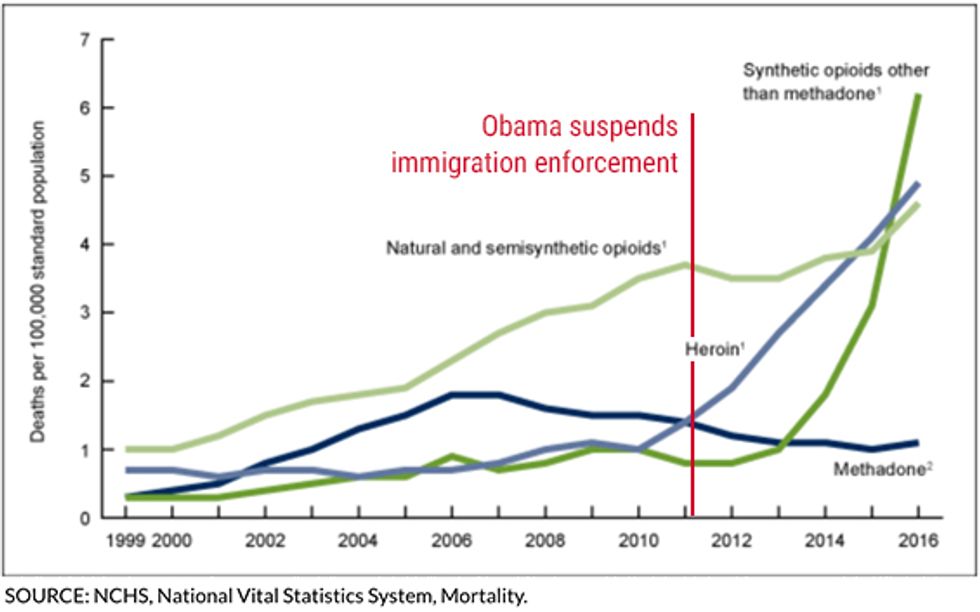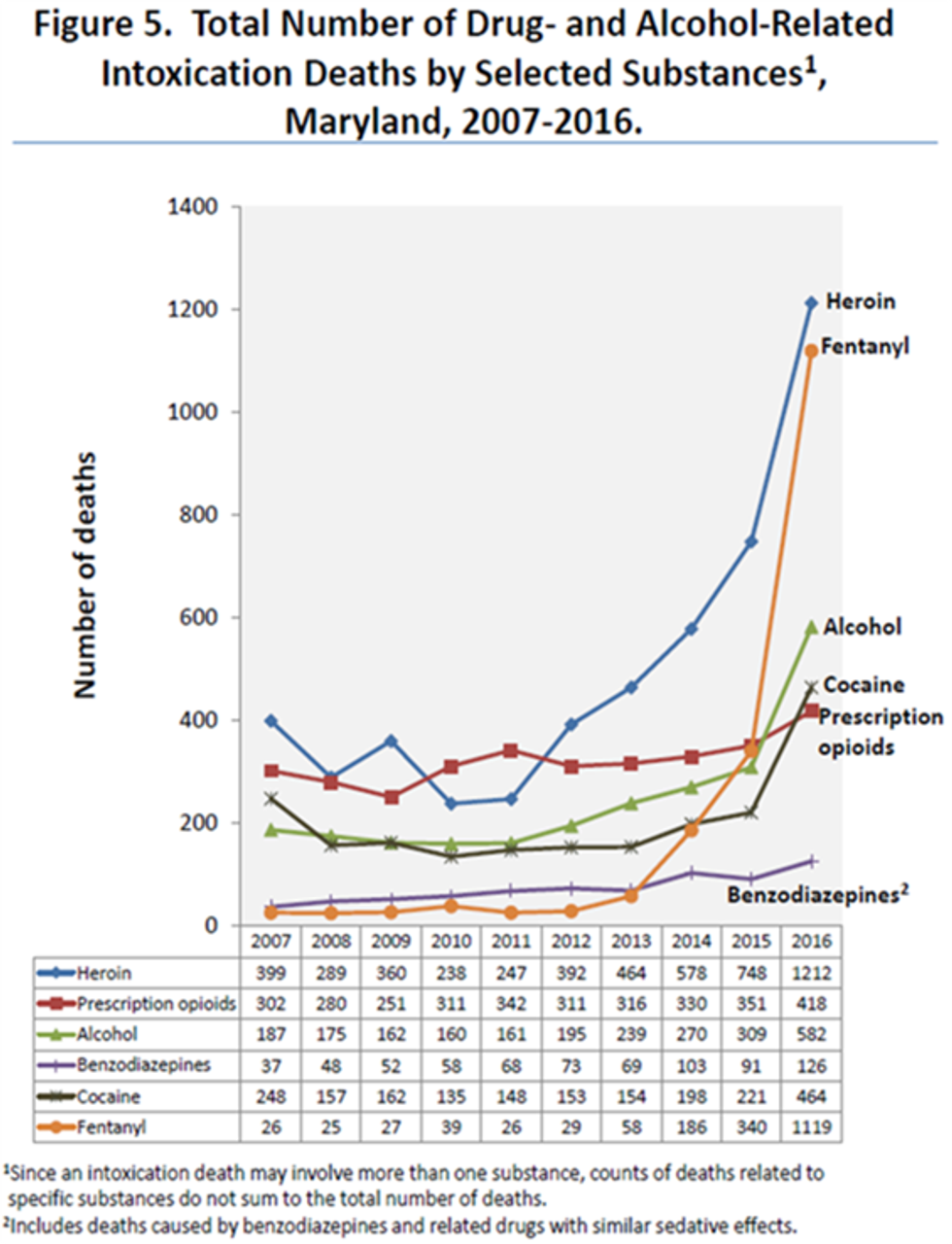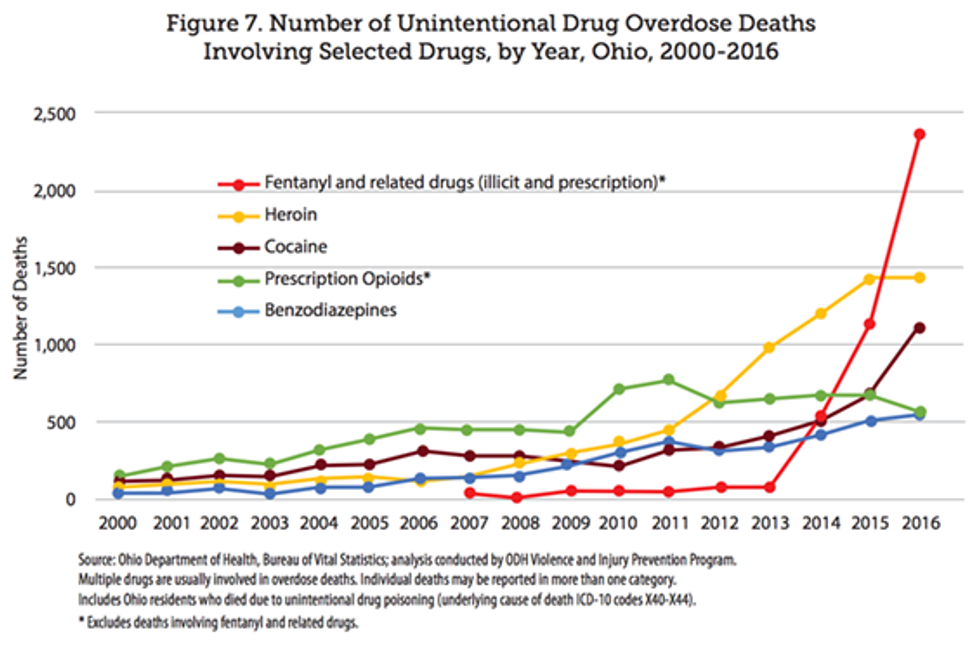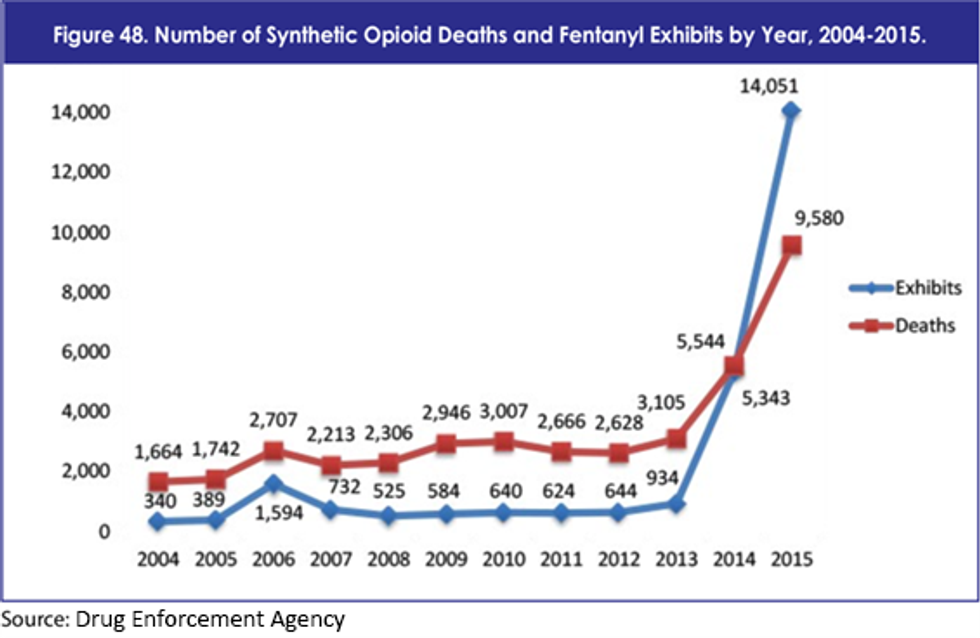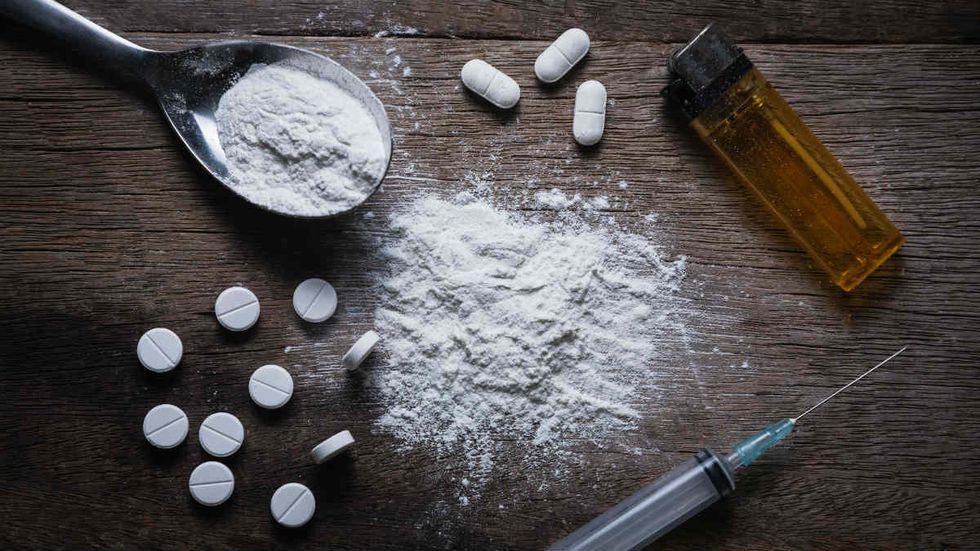
© 2024 Blaze Media LLC. All rights reserved.
Trump is right on drug traffickers: Heroin and fentanyl are killing US
March 16, 2018
Those who claim to be morally outraged by Trump’s proposal of the death penalty for drug traffickers, especially cartel leaders, either have no heart themselves or are oblivious to the worst drug epidemic ever and how it came about.
To understand the severity of the situation, we must first properly define the “opioid crisis” as it exists today and what has happened over the past four years.
What exactly is the “opioid crisis”?
We’ve always had drugs flowing into this country. But the supply and dangerous nature of the drugs coming into this country from Mexico (or from China and then distributed by the Mexican cartels) since 2013-2014 are at an epidemic level, dwarfing anything we’ve seen before. It all began with the suspension of immigration enforcement from 2010-2014 and suspension of interior enforcement. Transnational drug cartels worked with gangs and human smugglers to take advantage of Obama’s unprecedented dismantling of our borders in order to launch what should be described as chemical warfare on this country. If you read former senator and now Attorney General Jeff Sessions’ timeline on Obama’s dismantling of immigration security and border control, the timing of the drug crisis makes perfect sense.
Long before the medical profession was pressured in the ’90s (in part by government) to treat pain more often with prescription opioids such as oxycodone and hydrocodone, we had a culture of illicit drug use in this country. It was mainly marijuana and cocaine. Then it moved on to methamphetamine, and then to the more severe heroin. For the most part, this was not about pain-driven addiction, but a cultural collapse.
Beginning in the late ’90s, as prescription painkillers began to become a regular part of medical practice, the rate of overdoses on prescriptions steadily rose. The vast majority never became addicted and enjoyed a better quality of life thanks to the drugs, but commensurate with the increased use was an increase in drug overdoses by those who did become addicted.
The rate of prescriptions kept going up and peaked between 2010 and 2012 as a debate raged in the medical community and in state legislatures over whether prescription opioids were being overprescribed. Almost every state set up a monitoring program, and more than half of the states began to place restrictions on them, some of them severe. After peaking at 81.3 prescriptions per 100 persons in 2012, the rate declined precipitously, to 66.5 in 2016, according to the CDC, all the way down to 2002 levels.
The numbers are even starker on a state level. Let’s examine the states with the highest rates of drug deaths since 2012. West Virginia’s prescription opioid rate dropped from 136.9 per 100 persons in 2012 to 96 in 2016. In Ohio, it dropped from 97.5 to 75.3.; in New Hampshire, 83.7 to 64.3 (below the national average); in Pennsylvania from 83.3 to 69.5.; in Rhode Island from 83.2 to 60.3 (below national average). Yet the overall drug deaths skyrocketed to unimaginable levels in those states after prescription opioids became heavily regulated and the numbers plummeted.
Rather than a steady decline in fatalities from overdoses to match the decline in prescription opioids, everything went bonkers from 2013 to the present, after the public and politicians turned against the use of prescription opioids. We saw a spike in deaths of unfathomable proportions, getting worse every year through 2014, 2015, and 2016. The level of fatalities doubled and tripled in those states as, not surprisingly, heroin and fentanyl flooded the market.
Overdoses from illicit substances accounted for 78 percent of the 64,000 deaths in 2016, according to the National Center for Health Statistics. And all signs from 2017 state data I’ve examined point to an even sharper trajectory since then.
This chart says it all:
Maryland is one of the crisis states, with drug deaths quadrupling over the past five years, even as prescription opioid rates have dropped well below the national average. This one chart from the Maryland Department of Health is worth 1,000 words:
And here is the story in Ohio, the second worst drug overdose state:
Amazingly, some states with sky-high opioid prescription rates, such as Alabama and Arkansas, have some of the lowest overdose death rates in the country. And in Ohio, with the second highest rate of deaths from overdoses, just 13.9 percent had prescription opioids listed on the death certificate, while 58 percent had fentanyl and 38 percent heroin. Many of the latter had both. Prescription opioid deaths accounted for only 18 percent of overdose deaths in Maryland in 2017 and 12.2 percent of overdose deaths in Pennsylvania in 2016. The numbers of cocaine and meth overdoses have also gone up in Ohio and most states, but not nearly as much as heroin and fentanyl.
What is happening and why?
The epidemic we are facing today is not from prescription opioids, at least not more than it has been for an entire generation. The number of prescriptions has already been reduced dramatically, and the overdose rate has leveled off and even dropped in some of the most affected states since 2016, like Ohio. Almost the entirety of the increased fatalities above the long-term existing trajectory beginning in 2012 were from illicit drugs and mainly from the most dangerous one – heroin. Then, as heroin use began to skyrocket in 2013-2014, we began to see the growth of the cursed synthetic drug – fentanyl – which is 50-100 times stronger than morphine and can kill in small quantities. It’s often laced into heroin. In pretty much every state, fentanyl has skyrocketed to such a level that it has overtaken heroin as the leading drug killer. Cocaine and meth overdoses have also gone up a lot but are not nearly as serious.
Thus, we don’t have “an opioid crisis;” we have a heroin and fentanyl crisis.
Even worse, beginning in 2016 and 2017, carfentanil, which is 10,000 times stronger than morphine, has hit the streets. It is used in elephant tranquilizers and is essentially a form of chemical warfare against this country. One grain of this substance will kill someone, and you essentially need a hazmat team to deal with it or even get near it. Dozens of people died from it in my home state of Maryland and in many other states hardest hit by this epidemic.
The drug cartels have launched chemical warfare against us – and we are helping
What happened circa 2013 and just before? As I have noted before and will write extensively about in the coming weeks, this was the result of suspending our borders, the promise of amnesty, and the surge of hundreds of thousands of young Central American males who served as drug mules, enriching the drug cartels who control the smuggling routes and earn a profit from every illegal smuggled over – whether that illegal is a bad hombre or merely “doing the jobs Americans won’t do.”
Mexican heroin used to be dirty, impure, black tar heroin. Now, it’s high-purity powder heroin because the cartels were so enriched by the DACA-drive smuggling that they were able to ramp up their production and networks while using the new mules and gangs entering the country to expand their empires. They also began producing fentanyl, and with their expanded distribution network on our soil, were also able to traffic the Chinese fentanyl and carfentanil sent initially by mail.
The correlation with the rise in MS-13 as a result of the UAC surge in 2013-2015 completes the circle of cause and effect, because in recent years MS-13 gangs have become the distributers for the drug cartels. In a 2013 report, the Texas Department of Public Safety warned of the developing relationships between the drug cartels and the gangs and that the gangs “increase their power and acquire wholesale quantities of drugs at lower prices, while the cartels extend their network of connections deeper into the United States.” In subsequent reports in 2016 and 2017, the Texas DPS noted that the relationship remained “steady” and that “as long as illicit cross-border crimes are profitable, the relationship between cartels and gangs will continue.”
Sanctuary cities have ensured that this relationship is profitable. The 2017 Director of National Intelligence Worldwide Threat Assessment noted "the staying power of Mexican trafficking networks" as a cause of the skyrocketing drug crisis.
Judge Andrew Hanen of the Southern District of Texas, in a December 2013 order, charged that the Obama administration essentially “successfully complet[ed] the mission of the criminal conspiracy” of drug smugglers to smuggle people over the border on behalf of parents “at significant expense” to taxpayers. He observed that the DHS was taking actions that were “dangerous and unconscionable,” “subject to the whims of evil individuals,” resulting in the “absurd and illogical” outcome of helping “fund the illegal drug cartels which are a very real danger for both citizens of this country and Mexico.”
Hanen pointed out that “time and again, this court has been told by representatives of the government and the defense that cartels control the entire smuggling process.” He also observed that the cartels knew that teenagers would be treated leniently if caught with drugs. He therefore concluded that by dismantling immigration enforcement and promising amnesty, “the government is not only allowing them to fund the illegal and evil activities of these cartels, but is also inspiring them to do so.” In a footnote, Hanen ominously warned about the heroin smuggling that would likely follow, based on past history.
And the rest is indeed history. From 2013 to 2016, according to the Drug Enforcement Agency (DEA), the level of heroin production in Mexico tripled. And not surprisingly, right after 2013, is when the entire fentanyl phenomenon took off:
There is your culprit. There is your crisis. We have gone to war around the world for much less, yet Mexican drug cartels operating on our border and on our soil are never treated as the chemical warfare it is. The politics with “our Mexican friends” always prevents us from doing what it takes to stop them, even though many of their politicians are roped in with the cartels. We treat DACA – the cause of all of this – as the solution!
We could abolish doctors and pharmaceuticals tomorrow, and it would not change the problem: chemical warfare on our country from the Mexican drug cartels who now use MS-13 and similar gangs to distribute their poison. In fact, it can be posited that some of sudden spike in the crisis after the flow of prescriptions was tightened helped push more people into the illicit drug market, which is much more dangerous. At this point, any further effort to focus solely on prescriptions without dealing with the underlying cause of the explosion in supply of the most deadly illicit drugs is the worst policy outcome possible. Worst of all, those who are throwing billions of dollars at unproven federal treatment programs refuse to support tougher sentences for drug traffickers and, in fact, are trying to dismantle the existing mandatory sentences.
There is no penalty strong enough for these monsters
Which brings us back to the drug traffickers. The very people virtue-signaling about the “opioid crisis” and demanding a national prescription-monitoring database, endless government programs to enrich the health care industry, and severe restrictions on doctors are coddling the drug cartels and doubling down on their policies that fueled the worst elements of the worst drug epidemic. How dare they oppose minimum penalties for drug traffickers?
Rep. Jim Butler, a state representative from Ohio and a health care expert, spoke to me on my podcast earlier this week and explained how the ACLU blocked legislation in Ohio that minimally raised penalties on those who sold fentanyl to people coming out of drug rehab!
As we’ve noted before, there is a bipartisan obsession with retroactively releasing drug traffickers (not drug addicts) from prison and dramatically reducing penalties. Believe what you want about marijuana and cocaine, but today we are dealing with chemical warfare in our country. Obama released close to 2,000 drug traffickers from federal prison during his final two years, many of whom committed other violent crimes in addition to trafficking meth and heroin. Yet most members of Congress want to be even more lenient. Nor do they want to deal with interior immigration enforcement. We should at least all agree to severe penalties for fentanyl trafficking. And when you look at the tens of thousands of dead Americans as a result of fentanyl, the only problem you should have is that we can only kill these people once.
For those who are “offended” at the notion of giving the death penalty to those who peddle fentanyl and carfentanil, maybe they’d be happier if we punished traffickers by having them consume their own product. After all, it’s only drugs.
#mc_embed_signup{background:#fff; clear:left; font:14px;}
/* Add your own MailChimp form style overrides in your site stylesheet or in this style block.
We recommend moving this block and the preceding CSS link to the HEAD of your HTML file. */
Want to leave a tip?
We answer to you. Help keep our content free of advertisers and big tech censorship by leaving a tip today.
Want to join the conversation?
Already a subscriber?
Blaze Podcast Host
Daniel Horowitz is the host of “Conservative Review with Daniel Horowitz” and a senior editor for Blaze News.
RMConservative
Daniel Horowitz
Blaze Podcast Host
Daniel Horowitz is the host of “Conservative Review with Daniel Horowitz” and a senior editor for Blaze News. He writes on the most decisive battleground issues of our times, including the theft of American sovereignty through illegal immigration, theft of American liberty through tyranny, and theft of American law and order through criminal justice “reform.”
@RMConservative →more stories
Sign up for the Blaze newsletter
By signing up, you agree to our Privacy Policy and Terms of Use, and agree to receive content that may sometimes include advertisements. You may opt out at any time.
© 2024 Blaze Media LLC. All rights reserved.
Get the stories that matter most delivered directly to your inbox.
By signing up, you agree to our Privacy Policy and Terms of Use, and agree to receive content that may sometimes include advertisements. You may opt out at any time.
